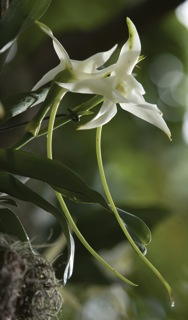Darwin’s Star Orchid
Posted in Around the Garden, Darwin's Garden, Gardens and Collections, The Orchid Show on March 29 2012, by Joyce Newman
Joyce H. Newman is a Garden Tour Guide with The New York Botanical Garden.
 Of the many thousands of orchids on display during the Orchid Show, the two most requested flowers are the vanilla orchid and what is known as Darwin’s orchid.
Of the many thousands of orchids on display during the Orchid Show, the two most requested flowers are the vanilla orchid and what is known as Darwin’s orchid.
The exquisite ivory, star-shaped blossoms of Darwin’s star orchid (Angraecum sesquipedale) are famous for their association with Charles Darwin and his theory of evolution.
The story goes that Darwin was sent a sample of the flower in 1862. Upon seeing its long, narrow nectar tube, he predicted that there must be an insect with a very long proboscis (a tongue-like part) that could reach deep within the hollow space to “drink” the nectar at the bottom. In so doing the insect would bump into the flower’s sticky pollen, enabling its transfer from one flower to another.
But no such insect had ever been seen in Madagascar where the orchid came from, or anywhere else. And many scientists believed Darwin was wildly wrong, so he was ridiculed for his prediction.
Nonetheless, Darwin firmly believed that the star orchid had developed its long nectar tube as an adaptation to help ensure pollination because orchid flowers have their pollen in a single mass and cannot disperse it as other flowers do. The orchids need their specific insect pollinators to survive.
Sure enough, about four decades after Darwin’s prediction, an insect with the exact physical characteristics that Darwin had predicted was discovered. Called the Hawk Moth, its scientific name is Xanthopan morganii praedicta, which is Latin for ‘predicted moth’ in honor of Darwin. (Watch a nighttime video showing the moth interacting with the orchid.)
Darwin was a serious student of orchids, which he examined and tested as he developed his theory of evolution. He also wrote a book on his experiments with orchids, entitled On the Various Contrivances by which British and Foreign Orchids are Fertilised by Insects. The star orchid turned out to be a perfect example of co-evolution, where two organisms—insect and flower—affect each other’s ability to grow and adapt.


Thank you so much….been wondering about this orchid for several years. Your story is very interesting and sheds so much light on this specimen. Thrilled to gain all this extra knowledge.